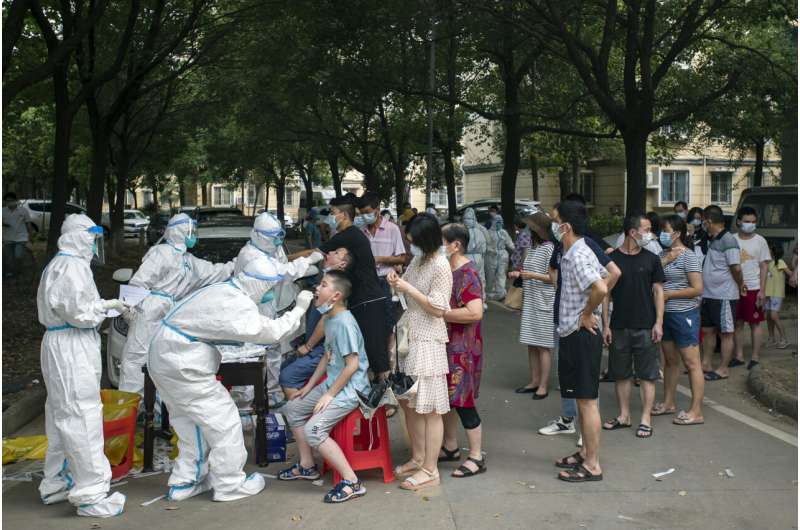Residents line up to be tested for COVID-19 on August 3, 2021 in Wuhan, Central China’s Hubei Province. Two new studies provide more evidence that the coronavirus pandemic originated in a market in Wuhan, China, where live animals were sold — giving rise to the theory that the virus originated in the wild rather than escaped a Chinese laboratory. The study was published online by the journal Science on Tuesday, July 26, 2022. Credit: Chinatopix via AP, File
Two new studies provide more evidence that the coronavirus pandemic originated in a market in Wuhan, China, where live animals were sold – bolstering the theory that the virus originated in the wild rather than escaped from a Chinese laboratory.
The research, published online Tuesday by the journal Science, shows that the Huanan Seafood Wholesale Market was likely the early epicenter of the plague that has now killed nearly 6.4 million people around the world. Scientists conclude that the virus that causes COVID-19, SARS-CoV-2, has likely been spilled from animals to humans on two separate occasions.
“All of this evidence tells us the same thing: It refers to this particular market in the middle of Wuhan,” said Kristian Andersen, a professor in Scripps Research’s Department of Immunology and Microbiology and a co-author of one of the studies. “I was pretty convinced about the leak in the lab myself, until we dug in very carefully and looked at it much more closely.”
In a studyIncorporating data collected by Chinese scientists, evolutionary biologist Michael Worobey of the University of Arizona and his colleagues used mapping tools to estimate the locations of more than 150 of the earliest reported COVID-19 cases as of December 2019. They also mapped cases from January and February 2020 using data from a social media app that had created a channel for people living with COVID-19 to get help.
They asked, “Of all the locations where the early cases could have lived, where did they live? And when we were able to look at this, it turned out that there was an extraordinary pattern where the highest density of cases are both extremely close to and very focused on this market” Worobey said at a press conference. “Critically, this is true for all cases in December as well as for cases with no known link to the market… And this is an indication that the virus started spreading among people working in the market, but then spread to the local community.”
Andersen said they also found clusters of cases on the market, “and that clustering is very, very specific in the parts of the market” where they now know that people were selling wildlife, such as raccoon dogs, that are susceptible to infection with the coronavirus.
In the other study, scientists analyzed the genomic diversity of the virus inside and outside China, starting with the earliest sample taken in December 2019 and extending to mid-February 2020. They found that two genera — A and B — marked the start of the Wuhan pandemic. Study co-author Joel Wertheim, a viral evolution expert at the University of California, San Diego, pointed out that lineage A is genetically more similar to bat coronaviruses, but lineage B seems to be more likely to spread in humans, especially on the market.
“Now I realize it sounds like I just said that a once-in-a-generation event happened twice in quick succession,” Wertheim said. But there were certain conditions, such as people and animals in close proximity and a virus that can spread from animals to people and from person to person. So “barriers to overflow have been lowered so that multiple introductions, in our view, should really be expected,” he said.
Many scientists believe that the virus jumped from bats to humans, either directly or through another animal. But in June, the World Health Organization recommended investigating more deeply whether a laboratory accident could be the cause. Critics had said the WHO was too quick to reject the lab leak theory.
“Have we disproved the lab leak theory? No, we haven’t,” Andersen said. “But I think what’s really important here is that there are possible scenarios and there are plausible scenarios and it’s very important to understand that possibly doesn’t mean equally likely.”
The origin of the pandemic remains controversial. Some scientists think a lab leak is more likely, and others are open to both possibilities. But Matthew Aliota, a researcher at the University of Minnesota Veterinary Medicine at the University of Minnesota, said in his mind that the pair’s studies “hopefully settle the lab leak hypothesis.”
“Both of these two studies provide really compelling evidence for the natural origin hypothesis,” said Aliota, who was not involved in either study. Since it’s impossible to sample an animal that was on the market, “this might be as close to a smoking gun as you could get.”
Michael Worobey et al, The Huanan Seafood Wholesale Market in Wuhan was the early epicenter of the COVID-19 pandemic, Science (2022). DOI: 10.1126/science.abp8715
Jonathan E. Pekar et al, The molecular epidemiology of multiple zoonotic origins of SARS-CoV-2, Science (2022). DOI: 10.1126/science.abp8337
© 2022 The Associated Press. All rights reserved. This material may not be published, broadcast, rewritten or redistributed without permission.
Quote: New studies support theory coronavirus came from the wild (2022, July 27) retrieved July 27, 2022 from https://phys.org/news/2022-07-bolster-theory-coronavirus-emerged-wild.html
This document is copyrighted. Other than fair dealing for personal study or research, nothing may be reproduced without written permission. The content is provided for informational purposes only.

